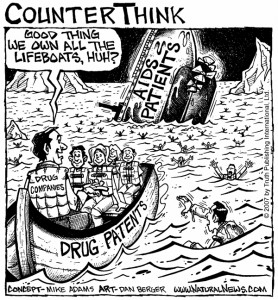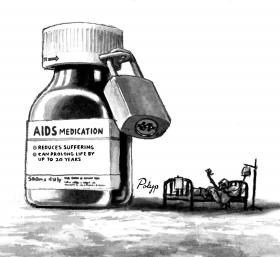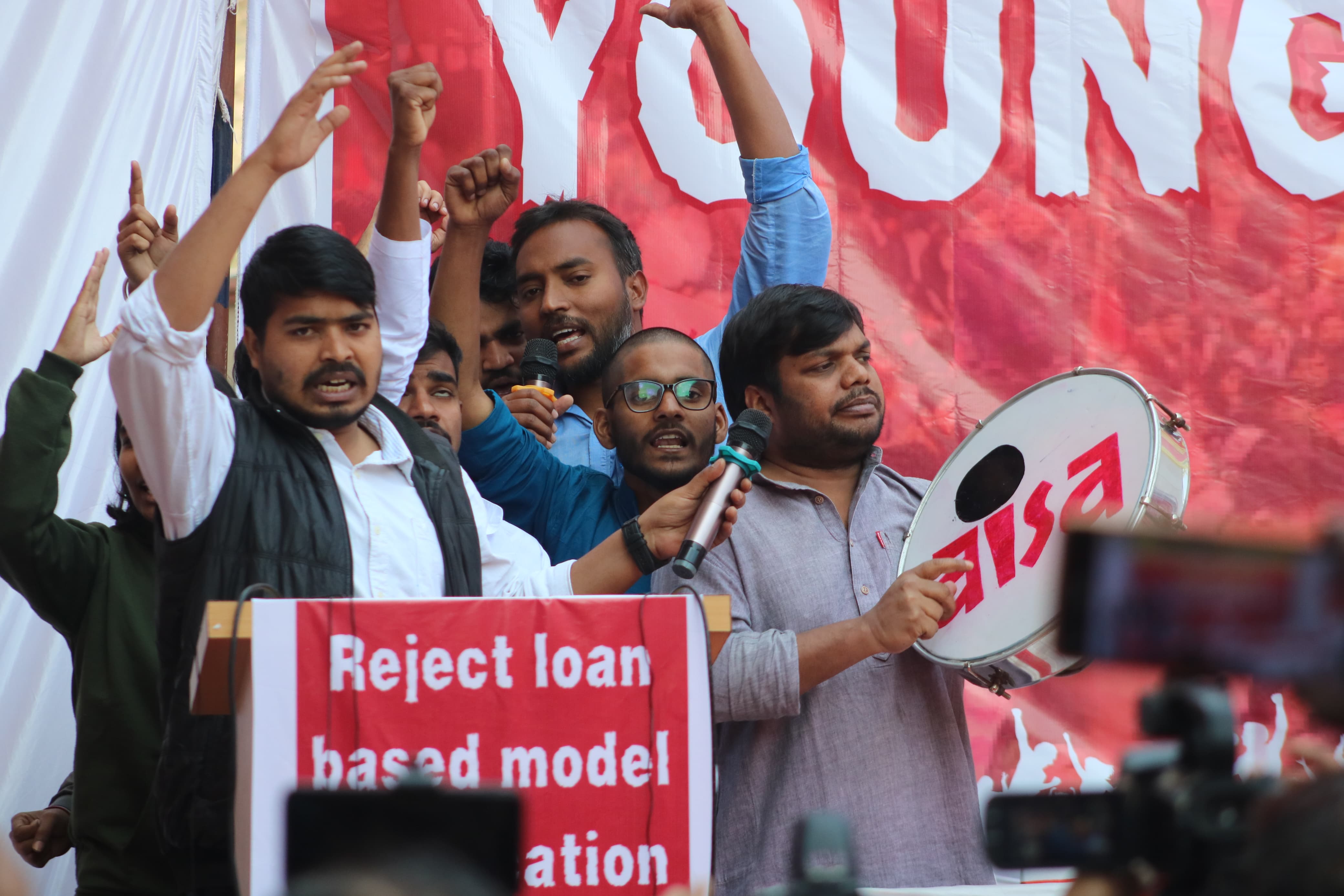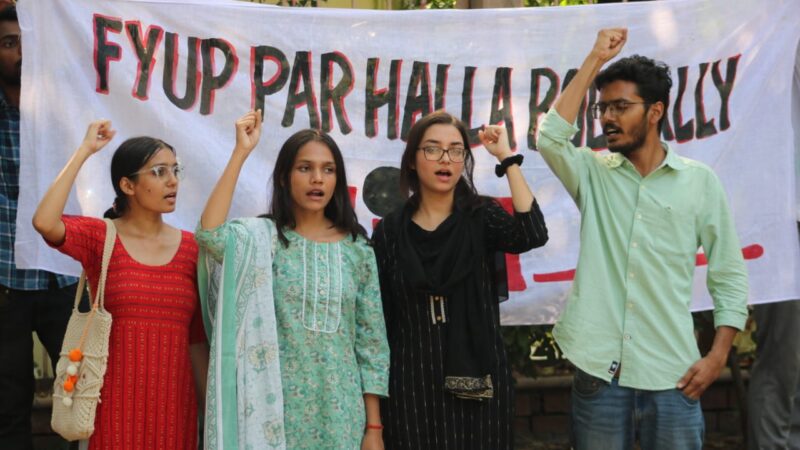Patent Over People? Modi Govt.’s Moves, Kept Under Wraps…
 Much hype and hyperbole has surrounded US President Barack Obama’s recent visit to India, with the Modi government trying it best to project this visit as a sign of India’s ‘emergence’ as a global power. Much is also being made of the Modi government’s pet ‘Make in India’ project.
Much hype and hyperbole has surrounded US President Barack Obama’s recent visit to India, with the Modi government trying it best to project this visit as a sign of India’s ‘emergence’ as a global power. Much is also being made of the Modi government’s pet ‘Make in India’ project.
Under all the hype, however, lies the plain fact that the Modi government has been busy ever since it came to power in know-towing to American strategic and corporate interests including US nuclear lobbies as well as US based multinational pharmaceutical companies. A particular area of concern has been in pharmaceuticals, as India is said to be the world’s top supplier of affordable generic versions of drugs under patent that otherwise would be out of reach for millions of poor patients. Several crucial policy changes are being mooted in the drug/pharmaceuticals sector and in our patent regime, which will literally endanger the health and lives of millions of Indians.
In less than six months, the Modi government has taken several steps that play into the hands of large international drug companies, or Big Pharma as these are popularly known, on a number of issues ranging from pricing of commonly-used medicines to intellectual property rights (IPR) of pharmaceutical formulations.
Some facts:
- · The first of these steps which came on the eve of the Prime Minister’s visit to the US in Sept 2014 entailed a rollback of guidelines issued by the National Pharmaceuticals Pricing Authority (NPPA). The guidelines, issued under the Drug Price Control Order, 2012, gave the NPPA the power to fix prices of even those drugs that were not on the national list of essential medicines. Using these guidelines, in July 2014, the NPPA had capped the prices of 108 medicines – most of them for cardiac diseases and diabetes, two very widespread ailments in India. Within two months of the NPPA order capping the prices of these 108 drugs, the government instructed it to revoke the guidelines. While it later clarified that the July cap on prices would still remain valid, the order has effectively ensured that the NPPA cannot take similar action in the interest of consumers in future. Given the timing of the move, this was nothing but an attempt by the Modi govt to send the “right signals” to US-based drug MNCs.
- · The second indication came in the US-India joint statement, issued at the end of Modi’s US visit, which stated that an annual “high-level intellectual property working group” would be set up, which would have “appropriate decision-making and technical-level meetings as part of the Trade Policy Forum”. It is well known how the American administration consistently uses ‘trade working groups’ to push for patenting rules that favour its Big Pharma lobby.
· Almost simultaneously Union Commerce and Industry minister Nirmala Sitharaman made a statement that the government would roll out a ‘revised policy on Intellectual Property Rights (IPR)’! She also indicated that this policy would focus on ‘boosting innovation and tone up the overall administration, besides setting up a ‘think- tank’ to strengthen the country’s patent regime !!
 Sitharaman’s statement to ‘revise’ the patent policy sounded an alarm bell among the public health activists. Countering the minister’s claim that ‘India doesn’t have an IP policy’, they pointed out that India had followed the Indian Patents Act 1970 till 1995 and then made use of the 10-year transition period provided by the WTO agreement on TRIPS to arrive at the current Indian IP legal regime after considerable debate inside and outside Parliament in 2005. So what is the REAL intent behind Sitharaman’s statement? Whose interests her govt is planning to serve by altering/overriding the present patent policy?
Sitharaman’s statement to ‘revise’ the patent policy sounded an alarm bell among the public health activists. Countering the minister’s claim that ‘India doesn’t have an IP policy’, they pointed out that India had followed the Indian Patents Act 1970 till 1995 and then made use of the 10-year transition period provided by the WTO agreement on TRIPS to arrive at the current Indian IP legal regime after considerable debate inside and outside Parliament in 2005. So what is the REAL intent behind Sitharaman’s statement? Whose interests her govt is planning to serve by altering/overriding the present patent policy?
The flexibility of ‘compulsory licensing’ in IPR available through TRIPS is what the US and its pharmaceutical industry have been vehemently objecting to and wanted to get scrapped. ‘Compulsory licensing’ essentially allows national govts to allow domestic companies to manufacture essential and life-saving drugs and sell them at cheap rates in emergency situations without the consent of the patent owner. This is one of the “flexibilities” on patent protection included in the WTO’s agreement under TRIPS. Compulsory licences are one of the most effective tools used by developing countries to break the monopoly pricing power of drug MNCs, especially for life-saving and essential drugs. Even the US government used this provision to threaten Bayer when the anthrax epidemic took place in 2009.
- · Subsequently, during the so called ‘Innovation Dialogue’ (16-21 Nov 2014) organised in India, in a glaring instance of conflict of interests, many pharmaceutical MNC representatives, as part of the delegation from US-based ‘Intellectual Property Owners’ Association’ (IPOA), arranged a meeting with members of Indian judicial tribunals, higher judiciary and officers who are dealing with intellectual property (IP) cases of these companies! It was clearly an attempt to influence judges regarding the outcome of some pending crucial cases related to IPR and important drugs.
- · The Modi government has appointed Arvind Subramanian as its the chief economic adviser: Subramanian is well-known for having advised the US government to initiate disputes against India before the WTO on pharmaceutical patents! Earlier, in written submissions to a US congressional committee as part of the process of review of IPR protection of various countries, including India, Subramanian has echoed the pet demands of the US pharma industry:
- “If India does not address the problems created by Section 3(d) of the patent legislation or by compulsory licensing… the US should consider initiating WTO disputes against India.” In that testimony he also wrote: “India could consider eliminating the additional efficacy requirement for patentability in Section 3(d) of its patent law.. India could commit to a stay on government-initiated compulsory licenses”.
- So now, the Modi-appointed chief economic advisor of the Government of India is essentially a US corporate spokesperson, who argues for dilution of provisions in the existing Indian patent law, and who wants to tweak laws to allow more profits for Big Pharma !!!
- · In August, the BJP government in Rajasthan drastically reduced the scope of the ‘Mukhyamantri Nishulk Dava Yojna’. Instead of keeping this free medicine scheme universal, the Vasundhara Raje government cut-off nearly 8.5 million people from the list of beneficiaries by stating that the scheme will be open only to beneficiaries of the food security scheme.
In just the past few months, BJP and the Modi government have clearly indicated that their priorities DO NOT lie in providing affordable and quality medical care to common people. Instead, they are far more interested in defending and protecting the profit drive of big Pharma lobby, which seek to gain from sickness and disease of people in Asia and Africa. Each and every step taken by the Modi government has moved towards this end – reducing the powers of the NPPA, providing American pharma lobbyists a dedicated ‘platform’ to push for pro-corporate patenting regimes, reducing the scope of free medical care and appointing pro-corporate voices on important posts in the government. One wonders how Modi expects Indian companies to mass-produce and sell affordable medicines ‘Made in India’ when the government is so busy know-towing to US corporate interests!
Meet India’s (?!?) Chief Economic Advisor
“US business faces three major challenges in India. Two challenges common to all foreign business are: first, the weak and uncertain regulatory and tax environment that affects the civil nuclear industry, infrastructure, pharmaceuticals, and more broadly the operations of foreign multinationals in India. Second, although the broad macroeconomic picture is one of opening and surging trade and investment, protectionism in selected sectors has re-surfaced. India is seeking increasing recourse to localization—in banking, telecommunications, retail, and solar panels among others—which favors domestic providers of inputs and equipment over foreign providers. Thus, broad trade and macroeconomic policies toward foreigners are moving in the right direction but sectoral policies have experienced setbacks.”
Who could have said this?
A trade specialist working for the US interests? An advisor to some US trade body or an advisor to the US government? Or an overseas critic of prime minister Narendra Modi’s plans to localise manufacturing? The answer is none of the above, but the current Chief Economic Advisor (CEA) Arvind Subramanian.
This is not a random statement that he could have made long ago, but has been taken from his testimony before the “Ways and Means Committee of the United States Congress”, which was hearing on “US-India trade relations.” in March 2013.
– excerpted from “India or US? Whose interests will the Chief Economic Advisor Subramanian serve?” by G Pramod Kumar published in Firstpost 21 Oct 2014 (http://www.firstpost.com/
READ ALSO:
Rise Up Against Modi Govt’s All-Out War against Public Education System
Resist Fascist Policing By the Saffron Brigade on Valentine’s Day!
What is the ‘Break-Up’ of the ‘Breakthrough’ of Modi’s Nuclear Diplomacy with Obama?
Reject the Politics of Assassination and Appropriation of Gandhi by the Communal Fascist Brigade!





